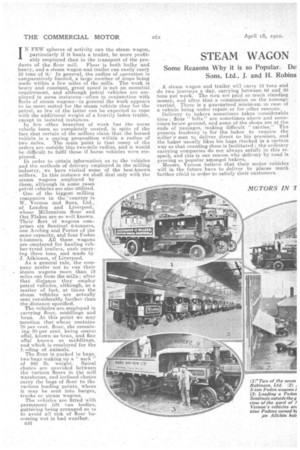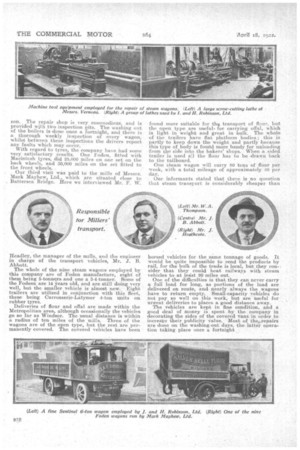STEAM WAGON GE FOR MILLERS.
Page 16

Page 17

Page 18

If you've noticed an error in this article please click here to report it so we can fix it.
Some Reasons Why it is so Popular. Del Sons, Ltd., J. and U. Robins Fleets and Methods Used by W. Vernon and Ltd., and Mark Mayhew, Ltd.
IN FEW spheres of activity can the steam wagon, particularly if it hauls a trailer, be more profitably employed than in the transport of the pro
ducts of the flour mill. Flour is both bulky and heavy, and a steam wagon and trailer can easily carry 10 tons of it.' In general, the radius of operation is comparatively limited, a large number of stops being made within a few miles of the mills. The work is heavy and constant, great speed is not an essential requirement, and although petrol vehicles are employed in some instances—often in conjunction with fleets of steam wagons—in general the work appears to be more.suited for the steam vehicle than for the petrol, as few of the latter can be expected to cope with the additional weight of a heavily laden trailer, except in isolated instances.
In few other branches of work has the horse vehicle been so completely ousted, in spite of the fact that oertain of the millers claim that: the horsed vehicle is a paying proposition within a radius of two miles. The main point is that ninny of the orders are outside this two-mile radius, and it would be difficult to fulfil these if horse vehicles were em ployed. . In order to obtain information as to the vehicles and the methods of delivery employed in the milling One of the biggest milling companies in the • country is W. Vernon and Sons, Ltd., of London and Liverpool, whose Millennium flour and Oat Flakes are so well known. Their fleet of wagons comprises six Sentinel 0-tormers, one Aveling and Porter of the same ,capacity, and four Foclert 5-tonners. All these wagons are employed for hauling rubher-tyred trailers, each carrying three tons, and made by J. Atkinson, of Liverpool. As a general rule, the company prefer not to run their steam wagons more than 12 miles out from the mills ; after that distance they employ petrol vehicles, although, as a matter of fact, at times the steam vehicles are actually sent, considerably farther than the distance specified. The vehicles are employed in carrying flour, middlings and bran. At this point we may mention that wheat contains 70 per cent, flour, the remaining 30..per cent. being coarse offal, known as bran, and fine offal known as middlings, and which is employed for the feeding of animals.
The flour is packed in bags, two bags making .up a" sack" of 280 lb. weight. Spiral chutes are provided between the various floors in the mill warehouse, and inclined chutes carry the -bags of flour to the various loading points, where it may be sent into barges, trucks or steam wagons.
The vehicles are fitted with permanent tilt van ,bodies, gutt6ring being arranged so la to avoid all risk of flour becoming wet in bad weather.
e16 A steam wagon and trailer will carry 10 tons and do two journeys a day, carrying between 60 and 80 tons per week. The men are paid so much standikg money, and after that a commission on the tennage carried. There is a guaranteed minimum in case of a vehicle being under repair Or for other reasons. Delivery to bakers sometimes takes .considerable time ; flour " lofts " are sometimes above and sometimes below ground, and some of the shops are at the ends of passages, making difficult " carries." The present tendency is for the baker to require the miller's. men to deliver direct to his premises, and the baker usually likes his hags stacked in a certain way so that counting them is facilitated ; the ordinary carrying companies do not always satisfy in this respect; and this is one reason why delivery by road is proving so popular amongst bakers. Messrs. Vernon believe that their motor vehicles will in the future have to deliver to places much farther afield in order to satisfy their customers.
They attach great importance to the advertising value of their vehicles, although it is very difficult to assess this. For this reason they keep the vehicles in first-rate condition, and they also pay great attention to the bags in which their products are packed, as it is most beneficial to their interests to deliver in neat, dean bags from clean wagons. Flour is very easily contaminated by any strong smell, such . as that enianating from onions, a new tarpaulin, etc. As an example of the -Work with which the -transport vehicles have to deal, they have delivered as many as 1,000bags in one consignment at a 'single
destination, this quantity representing tons.
. The company never used horsed 'vehicles in London, but employed steamwagons from the outset. Although they have a number of petrol vehicles, they are more in favour.of steam-wagons' for' their particular class of work. The main point is that two men must.. be sent with each wagon, and these can look alter the 10 tons carried on a steam wagon and
trailer just as well as they can look after the four or five tons carried on a petrol vehicle.
-Mueh of the efficiency of the fleet must-i3e. placed to the credit of Mr. H. M. Walker,the engineer to the company, and to the engineer in charge of the vehicles, Mr. J. Heritheete.
Another very large producer of flour is J. and H. Robinson and Co., Ltd.-, whose mills are situated at New Cross, London, S.E. This company have affect of 20 -steam wagons, including two 6-ton Sentinels, seven 5-ton Allchins and eleven 5-ton Foclens. The first Eoden was purchased in 1908, the first Allchin in 1916, and the first Sentinel 'in 1820. All these vehicles run on rubber tyres of Dunlop and Macintosh makes, and, as a general rule, haul trailers, of which there are 10 of Carrosserie-Latymer make. The average tonnage carried by each wagon per month is 250, and the customary limit of operation is 25 miles, although a few journeys have been made to places so far away as Southend, Essex. The vehicles are all provided with open bodies. The -company do not believe in the permanently covered vehicle, as loading and unloading can be done much more readily with the former type, whilst protection from rain is obtained by the use of tarpaulins.
The bags of flour-and offal are passed 'down spiral chutes and along conveyor hands to the vehicle-loading chutes, which are of a special pattern with tipping ends; so arranged that the bags __are automatically brought into the best position for carrying.
The vehicles are employed chiefly. on carrying flour to customers and offal to the railhead, from which it is sent to farmers in various parts of the .country. Occasionally a return lead of English wheat is obtained from the railhead; but, as a rule, the vehicles have to return empty, although the delivery department of the company-plans out journeys in order to utilize the vehicles in the most efficient manner.
They have not employed a horse for seven years, although they believe that up to two miles the horse is quite efficient; but, to put it in their own words, " the bulk of the trade does not lie upon oneFs doorstep ; it is necessary to go farther . afield."
They keep very careful costs and treat the transport department almost as a separate company, -so that they can estimate the cost of the vehicles as if they Were supplied by an outside contra-ctor. They consider that the most important points about running vehicles is to keep them fully laden for the greater part of the time, and to keep theni on the road. They do all their own repairs, and have amodern and well-equipped engineering department provided with machine tools of all necessary types, and the chief engineer of the mill, who also ha§ control of the ttansport, vehicles, is Mr. W. A. Thomp son. The repair shop is very commodious, and is provided with two inspection pits. The washing out of the hollers is done once a Tortnight, and there is a thorough weekly inspection of every wagon, whilst between these inspections the drivers report any faults which may occur. With regard to tyres, the company have had some very satisfactory results. One Foden, fitted with Macintosh tyres, did 25,000 miles on one set on the hack wheels, and 30,000 miles on the set fitted to the front wheels. .
Our third visit was paid to the mills of Messrs. Mark Mayhew, Ltd., which are situated close to Battersea Bridge. Here we interviewed Mr. F. W.
Headley, the manager of the nulls. and the engineer in charge of the transport vehicles, Mr. J. B. Abbott.
The whole of the nine steam wagons employed by this company are of Foden manufacture, eight of them being 5-tonneFs and one a 3-4-tonner. Some of the Fodens are 14 years old, and are still doing very well, but the smaller vehicle is almost new. Eight trailers are utilized in conjunction with this fleet, these being Carrosserie-Latymer 4-ton units on rubber tyres.
Deliveries of flour and offal are made within the Metropolitan area, although occasionally the vehicles go so far as Windsor. The usual distance is within a radius of ten miles of the mills. Three of the wagons are of the open type, but the rest are permanently covered. The covered vehicles have been
found more suitable for thci transport of flour, but the open type are useful. for carrying offal, which is light in weight and great in -bulk. The whole of the trailers have flat platform bodies.; this is partly to keep down the weight and partly because this type of body is fourld more handy for unloading from the side into the bakers' shops. When a.sided trailer is used all the flour has to be drawn back to the tailboard.
One steam wagon will carry 80 tons of flour per week, with a total mileage of aPproximately 40 per day.
Our informants stated that there is no question that steam transport is considerably cheaper than horsed vehicles for the same tonnage of goods. It would be quite impossible to send the products by rail, for the bulk of the trade is local, but they conBider that they could beat railways with steam vehicles to at least 20 miles out.
One of the difficulties is that they can never carry a full load for long, as portions of the load are delivered en route, and nearly always the wagons have to return empty. Small-capacity vehicles do not pay so well on this work, but are useful for urgent deliveries to places a good distance away. The vehicles are kept in fine condition, and a good deal of money is spent by the company in decorating the sides of the covered vans in order to inereate their publicity value. Most of the.repairs are done on the washing-out days, the latter operation taking place once a fortnight


































